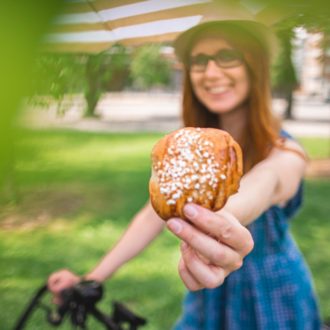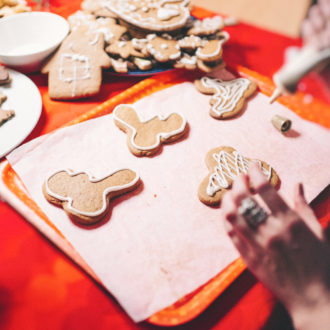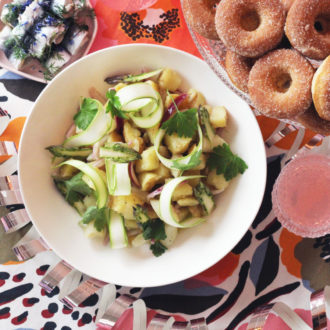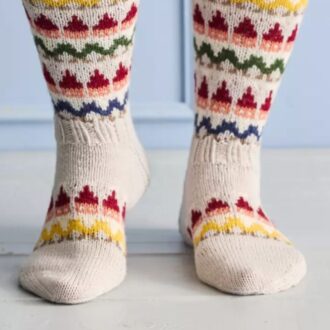Whether you call them cookies or biscuits, they taste great. Finnish has at least two different words for them: keksi and pikkuleipä (the latter actually means “little bread”).
You can trace the origins of many Finnish cookies to continental Europe. Some of them have changed more than others over the years.
Chocolate-dipped gingerbread cookies
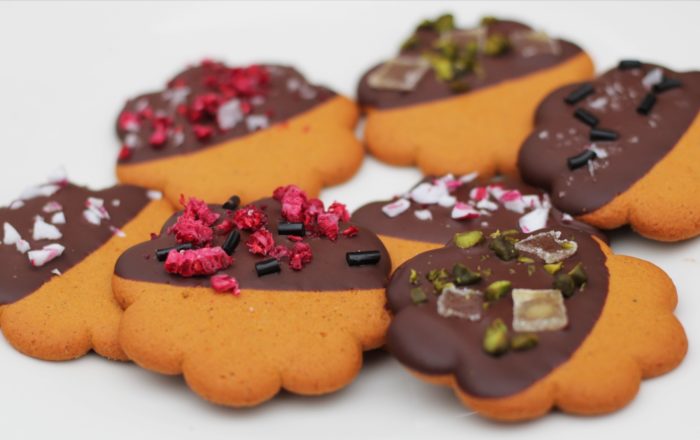
Gingerbread and chocolate form a perfect combination.Photo: Piritta Kaartio
Gingerbread is a fun way to bake with the kids. We all love gingerbread, but with this recipe you can add more taste and different textures and have fun decorating the cookies.
You can buy gingerbread from the store or, better yet, make it yourself [see ThisisFINLAND’s Finnish Christmas cookbook page]. I chose to dip the cookies into dark chocolate, but you can use any kind of chocolate you like. This is like taking your cookies to the next level. I prefer to use high quality chocolate because you can really tell the difference in flavour. As a garnish, you can choose your favourites. Good matches are candied orange peels or white chocolate chips. Chocolate can be melted in a bain-marie, or gently in a microwave.”
- 20 gingerbread cookies
- 200 g good-quality dark chocolate
- Candied ginger and pistachios
- Crushed candy canes and soft liquorice
- Freeze-dried raspberries and salt flakes
- Baking paper
If necessary, cut the garnishes into smaller pieces. Coarsely chop chocolate and place it in a bowl that can be used on top of a saucepan. Add a small amount of water into the saucepan and place the bowl of chocolate on top. Gently heat up the water, but do not boil. Let the chocolate melt gently without stirring too much. Once the chocolate has melted completely, take the pan off the stove.
Dip gingerbread cookies halfway into the melted chocolate and place them on the baking paper. Sprinkle desired garnishes over the chocolate parts and let cool completely.
Old customs and new ones
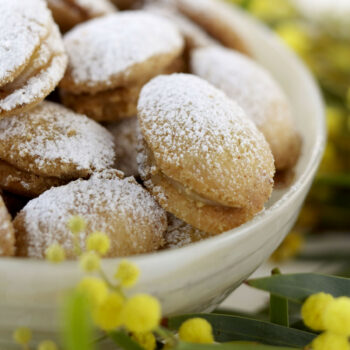
You make these delicacies, called Finnish spoon cookies, by scooping dough onto a baking sheet with a teaspoon. Later you add the filling and sprinkle them with sugar.
Photo: Norman Ojanen/Otavamedia/Lehtikuva
Local ingredients and customs vary depending on the region and the occasion, but buns and cookies have a place of honour wherever and whenever coffee is served. And coffee is served a lot in Finland (you can always get tea, as well).
You can make vegan versions of all these cookies, too. The results may vary according to the kind of plant-based substitutes available. Plant-based margarines, milks, creams and egg substitutes are different from country to country, so if you want to veganise, I recommend trying different variations until you find the ones that work best.
For more baked goods recipes, be sure to check out our other recipe articles, including Finnish baked goods, modern Finnish Christmas cuisine, traditional Finnish Christmas food and May Day brunch.
Crispy oat cookies (kauralastu)
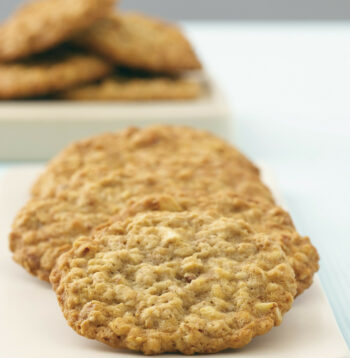
Photo: R&R/Stockfood/Lehtikuva
These thin cookies can be shaped after baking. As soon as you remove them from the baking sheet, you can drape them on top of a rolling pin while they cool. Or you can shape them over a wine cork to create a basket shape, then fill them with something delicious for a lovely dessert. Just be careful because they are very hot. You can also leave them to cool on the baking sheet if you’re not going to shape them.
- 100 g sugar
- 85 g butter
- 35 g rolled oats
- 70 g all-purpose flour
- 1 tsp baking soda
- 2 tbsp cream
- 2 tbsp golden syrup
- pinch of salt
Preheat the oven to 180 degrees Celsius.
Mix all the dry ingredients together. Melt the butter in a pan that also has room for the dry ingredients. After the butter has melted, add the rest of the ingredients. Using a tablespoon, scoop the batter onto a prepared baking sheet, leaving approximately 15 centimetres between cookies (they will flatten out and spread). Bake for about seven or eight minutes, until edges are golden brown.
S-shaped cinnamon cookies (kaneliässä)
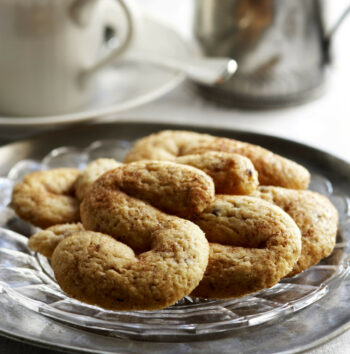
Photo: Jorma Marstio/Otavamedia/Lehtikuva
The name for these cookies comes from their shape. Each one looks like a letter “S.” There are two different approaches to making them: either roll them by hand or use a piping bag. If you’re going to roll them, you have to chill the dough in the fridge for two hours. Then make thin logs and twist them into the shape of a letter “S.” This recipe is for piping the “S” shapes straight onto a baking sheet. That’s much faster and tidier, and it also lets you do all sorts of other letters, too.
- 275 g sugar
- 125 g butter (room temperature)
- 3 eggs
- 1–2 tsp cinnamon
- 1 tsp baking powder
- 350 g flour (all-purpose)
- pinch of salt
Topping:
- 30 g sugar
- 1 tbsp cinnamon
The butter must be at room temperature when you start making the dough. The best way is to leave the butter at room temperature overnight or for at least for six hours. If you don’t have six hours, you can temper the butter with the gentle use of a microwave oven, but you need to be careful not to melt the butter. Place the butter and the sugar in a bowl and whisk with a mixer until it is a pale colour.
Add the eggs one by one, mixing until smooth after each one. Mix the dry ingredients together and sift them over the whisked butter. Mix carefully with a spatula.
Place the batter into a piping bag; you can use a tip of your choice but it’s not necessary. Preheat oven to 200 degrees Celsius. Pipe the shape of a letter “S” approximately five centimetres tall onto a prepared baking sheet. When all the cookies are piped, mix the cinnamon-sugar topping and sprinkle it over the cookies. Bake the cookies for 12 to 14 minutes and let them cool them on the baking sheet.
Aristocratic sandwich cookies (herrasväen pikkuleipä)
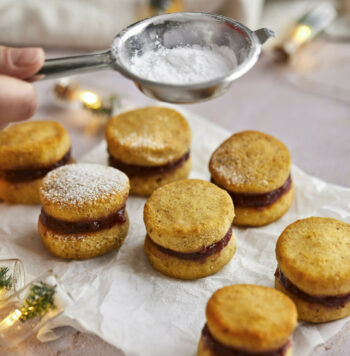
Photo: Natasa Dangubic/Stockfood/Lehtikuva
These sandwich biscuits traditionally have a raspberry jam filling, but you can vary them according to the season. How about rhubarb and ginger jam in the spring, or caramel made from condensed milk and seasoned with a touch of cardamom and salt for the holiday season? You can also cut a small hole with a tiny cookie cutter in every second cookie, for decoration and to provide a glimpse of what’s inside. Remember to make enough, because these cookies tend to vanish quite quickly!
- 200g butter
- 150 g sugar, plus extra for the coating
- 1 egg
- 3 tbsp cream
- 70 g corn or potato starch
- 1 tsp vanilla extract
- 1 tsp baking powder
- 200 g flour (all-purpose)
- pinch of salt
- 200 g jam
The butter must be at room temperature when you start making the dough. The best way is to leave the butter at room temperature overnight or for at least for six hours. If you don’t have six hours, you can temper the butter with the gentle use of a microwave oven, but you need to be careful not to melt the butter. Place the butter and the sugar in a bowl and whisk with a mixer until it is a pale colour.
Add the egg, cream and vanilla extract and whisk until smooth. Mix all the dry ingredients together and sift them over the whisked butter. Mix carefully.
Cover the dough with cling film and place the bowl in the fridge for one to two hours. Preheat the oven to 180 degrees Celsius. There are two ways to shape the cookies. You can roll the dough into a log approximately six centimetres in diameter and cut discs with a knife while the dough is very cold, or you can roll out the dough with a rolling pin and use a six-centimetre cookie cutter. The discs should be around four millimetres thick. Place the discs on a prepared baking sheet and bake them for eight minutes. While the biscuits are still warm, place a small amount of your chosen jam on half of them and put the others on top of them to form sandwiches. If you’ve cut decorative holes some of them, use those as the lids. Coat the biscuits with sugar and enjoy.
Wilhelmiina cookies
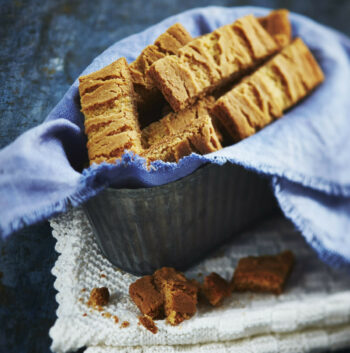
Photo: Jorma Marstio/Otavamedia/Lehtikuva
These cookies are quite easy to make and there are many variations. You can use different sugars or a mix of sugars. Try normal white caster sugar, or replace half the amount with dark muscovado sugar or brown sugar. Season with your spices of choice, for example cinnamon or ground ginger. Or you can add a tablespoon of coffee like my sister does. The dough is quite crumbly, so you have to be patient when shaping it.
- 200 g butter
- 170 g sugar
- 2 tbsp dark syrup or molasses
- 1 egg yolk
- 2 tsp vanilla extract
- 2 tsp baking soda
- (1 tbsp of coffee)
Preheat the oven to 175 degrees Celsius.
The butter must be at room temperature when you start making the dough. The best way is to leave the butter at room temperature overnight or for at least for six hours. If you don’t have six hours, you can temper the butter with the gentle use of a microwave oven, but you need to be careful not to melt the butter. Place the butter and the sugar in a bowl and whisk with a mixer until it is a pale colour.
Add the egg yolk and the syrup (and coffee). Mix all the dry ingredients (and ground spices) together and sift them over the whisked butter.
Mix until you have a crumbly dough. On a prepared baking sheet, shape it into two or three logs approximately two centimetres in diameter, leaving at least ten centimetres for the cookies to spread out. Bake for around 15 to 20 minutes, and as soon you remove the baking sheet from the oven, cut the cookies into slice three centimetres thick, holding the knife at a bit of diagonal. Leave them to cool, and then enjoy.
Finnish spoon cookies (lusikkaleipä)
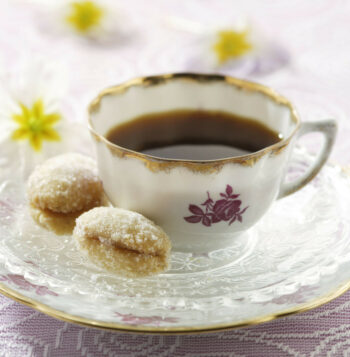
Photo: Mirva Kakko/Otavamedia/Lehtikuva
The name provides a clue about how you shape these cookies. You press the dough with a spoon to make oval-shaped cookies. They can be filled with different kinds of jams, but most common ones are apple or raspberry – just make sure that the jam you’re using is firm enough not to ooze out. Tip: if you want to add a “Finnishing touch,” you can mix a bit of liquorice powder into the sugar you use to coat the cookies. This goes really well with raspberry or blackcurrant jam.
- 200 g butter
- 140 g sugar, plus extra for the coating
- 260 g flour (all-purpose)
- 1 tsp baking soda
- pinch of salt
- 150 g jam of choice
Place the butter into a pan and melt it at moderate heat. Stirring the melted butter occasionally, continue until it turns a bit brown. Cool the butter in a heatproof mixing bowl. Preheat the oven to 175 degrees Celsius. Mix all the dry ingredients together and then mix them with the browned butter. Keep going until you have a firm but crumbly dough.
Prepare a baking sheet with baking paper or a silicone mat. Using a teaspoon, scoop a heaped spoonful of the dough and scrape the excess by dragging and pressing the spoon upside down against the edge of the mixing bowl. Push the shaped dough gently with the help of a finger flat side down on to the baking sheet. Do this until the whole batch of dough is gone.
Bake for 12 minutes and leave to cool slightly. Put some sugar into a soup dish for coating. When the cookies are still a bit warm, place a bit of your chosen jam onto the flat side of one cookie, then take another cookie and press the flat side gently on top of the jam. Roll the cookie in sugar.
By Timo Lepistö, January 2023
